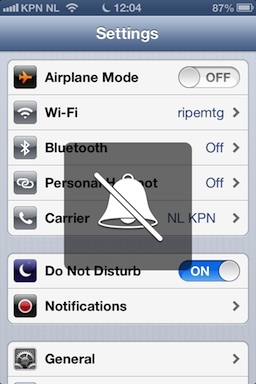None of the Nokia phones I owned before I got my first iPhone had a ring/silent switch. If you wanted to silence them, you had to go into a menu and tell the phone to be silent. The switch seemed like an obvious improvement: with it, you could silence your phone without even taking it out of your pocket. But an actual old-school switch that is moved between two different positions also has a big fat downside: you can't really set the same function in software, because then the behavior of the phone no longer complies with the position of the switch.

And so it was with the iPhone for five years. Yet with iOS 6, Apple gave us a way to silence our iPhones through a menu, and program the function to activate and deactivate at designated times. As such, the irresistible force (software programmability) met the immovable object (switch position/behavior parity).
Apple simply sidesteps this by retaining the ring/silent switch functionality as-is, and adding "do not disturb" as a completely separate function. And yes, R/S and DND really do perform different functions. Look closely at the names to divine the difference. With the switch in the silent position, the phone won't generate any sound. (With some exceptions, see below.) And "do not disturb" makes sure the phone doesn't disturb you.
In "regular" silent mode, the screen is still fair game. When there's an incoming phone call, the screen lights up, and you can take or ignore the call as usual, except the people around you are spared from having to listen to your favorite ringtone. It's the same with other kinds of notifications: the screen comes on, and unless you changed the "vibrate on silent" setting to off, the phone also vibrates to catch your attention. If that happens a lot throughout the night, an iPhone on your nightstand could certainly interfere with a good night's sleep.

Things are very different with "do not disturb." If you get a call when DND is in effect, the call is sent straight to voicemail. The screen doesn't come on, the phone doesn't vibrate, there is no sound. Same thing with notifications. (Well, they don't go to voicemail.)
However, there is one tiny little exception to this undisturbed bliss: if the screen is unlocked, none of the above applies: calls come through and notifications notify, with all of the ringing and beeping and vibrating that this entails. In other words: the phone won't disturb you, because if the screen is unlocked, your attention is on the phone anyway. Your significant other sleeping next to you may still be disturbed by all of this, though.
So: does it make sense to have two separate features that kinda-sorta-but-not-really do the same thing?
Yes and no. There have been a few times when my iPhone woke me up in the middle of the night, and with DND automatically enabled around bed time, such an event is less likely to happen in the future. (Creating a ringtone that is just 30 seconds of silence and assigning that to that guy who kept calling me throughout the night also helped.) But being able to silence my phone without even taking it out of my pocket using the ring/silent switch is fast and discreet, so I'd hate to give that up. And with the DND exemption when the screen is on, there are cases where you might want to use both of them at the same time.
Still, I expect that the somewhat subtle differences between the DND and R/S switch behaviors will be lost on most iPhone users. The likely result will be that people will still be disturbed more than they like, or unintentionally miss calls and notifications.
Since notifications sound and calls ring when DND is in effect (with the phone unlocked so the screen is turned on), it comes off as counterintuitive and will lead to unpleasant surprises. And it's likely that a lot of people have no need to differentiate between R/S and DND. Having an option to make DND activate when the R/S switch is switched to silent would be nice.
Although having DND activate automatically at a scheduled time is a great feature, having it deactivate at a scheduled time isn't always ideal—for instance, when sleeping in during the weekend. Why not have an option to automatically deactivate "do not disturb," when you first unlock your phone in the morning? (We'll call this "autodisturb" for short.)
Last but not least, Apple hasn't addressed the issue of alarms. Unbeknownst to some, alarms still go off when the R/S switch is set to silent, and also in DND mode. I think that's probably the best choice, but it's not ideal: on the one hand, it's disruptive and embarrassing when an alarm goes off when attending a performance. But on the other hand, you don't want to oversleep because you accidentally left the R/S switch set to silent, or left DND on so alarms remain silent.
It's just too easy to forget that the phone is silenced, because over normal usage, there's nothing conspicuous to remind you. Yes, I know it's easy enough to turn my iPhone on its side and look for the little orange stripe that indicates it's in silent mode. But what if I forget to do that, too?
Despite arguments that the current behavior is correct or that it isn't, there is no way to make the embarrassing-interruption-versus-oversleeping issue magically go away. But it would be huge step in the right direction if the lock screen showed when alarms, reminders, and calendar alerts are scheduled to go off if the iPhone is in silent or DND mode. With the ability to slide and immediately go to the place where that alarm, reminder, or alert can be disabled, of course.
(Bonus tip: if you ever have a call at an inopportune moment, you can silence the ringer—with the call continuing to "ring" silently—by pressing the sleep/wake button or one of the volume buttons. Press the sleep/wake button twice to send the call to voicemail.)
So please, Apple, wake up and fix this for us.
reader comments
96